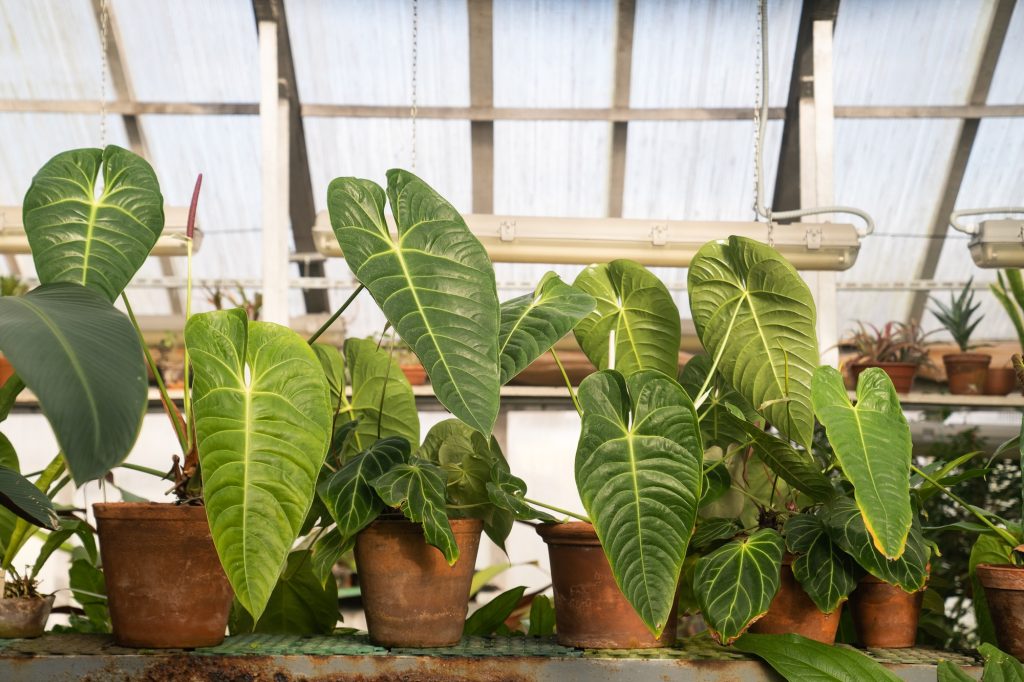The Alocasia plant is popular for its unique foliage markings that easily captivate onlookers and heighten the outlook of any environment they are grown in. Their impressive foliage designs complement both the interior and exterior design of any home they are situated in.
Growers select specific varieties due to the foliage patterns they possess. The Alocasia Plant does not produce attractive flowers during its bloom season. This houseplant can be situated anywhere in the home or office.
However, it is best to situate them in locations where they can be easily sighted. The best of the Alocasia is gotten when they are properly tended to and are placed in attractive containers or creature structures like dangle baskets or hanging shelves.
Most Alocasia varieties are beginner-friendly as they do not require much experience and resources to be propagated and to thrive. Since they are common plants, most varieties are inexpensive and can be easily purchased from nurseries or online plant stores.
The Alocasia plant can be the next houseplant on your to-grow list. As a beginner-friendly plant, you really cannot go wrong with this plant. This article contains a list of the most attractive Alocasia plants.
Alocasia Plant Basic Information and Care Tips
This profile sums up needed information about your Alocasia plant.
| Botanical Name | Alocasia spp. |
| Native Origin | South-East Asia |
| Foliage colour | Green |
| Watering | Moderate Watering |
| Temperature | 60°F-75°F` |
| Soil Type | Organic Soil |
| Fertilizer | Liquid NPK Fertilizer |
| Propagation Type | Indoor/Outdoor Propagation |
| Susceptible Plant Issues | Wilting leaves, falling leaves, Fading foliage colour and Pest Infestations. |
| Common Pests | Mealy Bugs, Spider mites, Scales, and Aphids. |
| Toxicity level | Toxic to pets and humans. |
Care tips always come in handy for growers as it helps wade through a hitch-free propagation. These tips would guide you as you start your propagation journey:
- Choose an area where your Alocasia can receive sufficient lighting. For them to thrive, they must receive about 5 hours of sunlight daily.
- Fertilize your Alocasia plant once a month. The appropriate time for fertilization is during spring and midsummer.
- Apply fertilizers moderately as recommended by the producers. Over-fertilization can damage the plant.
- Regularly mist their leaves.
- Employ the use of a moisture gauge to determine the needed amount of watering. This helps prevent underwatering or overwatering.
- After watering, ensure the soil of the Alocasia never ends up waterlogged. This can lead to root rot which is a leading cause of many plant problems.
- Ensure you have pesticides and gardening equipment within reach. Some of this equipment are gardening gloves, scissors, shears, misting bottles, moisture gauge, humidifiers e.t.c. This equipment can be purchased from stores whether online or onsite.
- Join a community of house plant growers to glean from their wealth of experience and to share your propagation journey.
- Keep your pets and kids away from the Alocasia plant. Ingestion could lead to serious health issues.
- Regularly lookout for pests and changes in foliage appearance of the Alocasia plant. Change in the foliage color and vigor are indicators to plant issues that may have occurred.
Alocasia Varieties: 10 Varieties You Can Propagate Today
All your Alocasia plant needs to thrive is proper watering, moist organic soil, warm temperature, periodic fertilization, regular misting, and a pest-free environment. So, these are the attractive Alocasia varieties that would easily enhance the outlook of your home.
1. Alocasia Amazonica
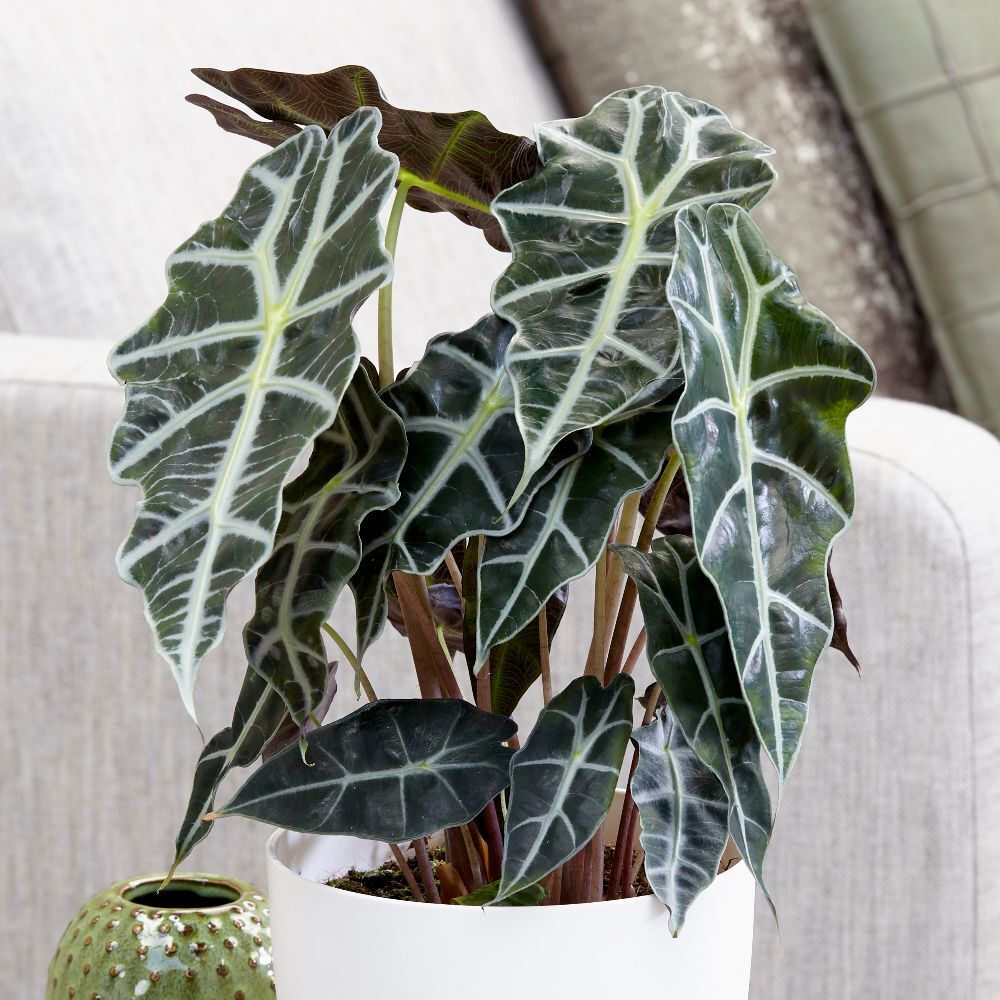
The unique markings of the Alocasia Amazonica are one reason this plant is a common option for house plant growers. For foliage shape, the Amazonica variety has arrow-shaped leaves with wavy edges. On the foliage surface, there are light shades of green markings.
They are compact and would complement any location it is placed in. Due to their unique foliage design, growing them in brightly coloured containers complements their attractiveness. They are mostly grown as indoor plants but are good options for outdoor propagation.
They can grow up to 18 inches in height and width. The Alocasia Amazonica produces flowers when grown outdoors, but they are inconsequential. Their essence lies in their unique leaves and not the flowers.
They are not only easy to propagate but can be maintained with the provision of basic growth needs such as adequate watering, proper lighting, organic soil, warm temperature, and regular misting.
If the Amazonica plant placement does not allow sufficient sunlight, employ the use of artificial light. You must ensure this plant is not grown in a poorly lit environment.
2. Alocasia Melo
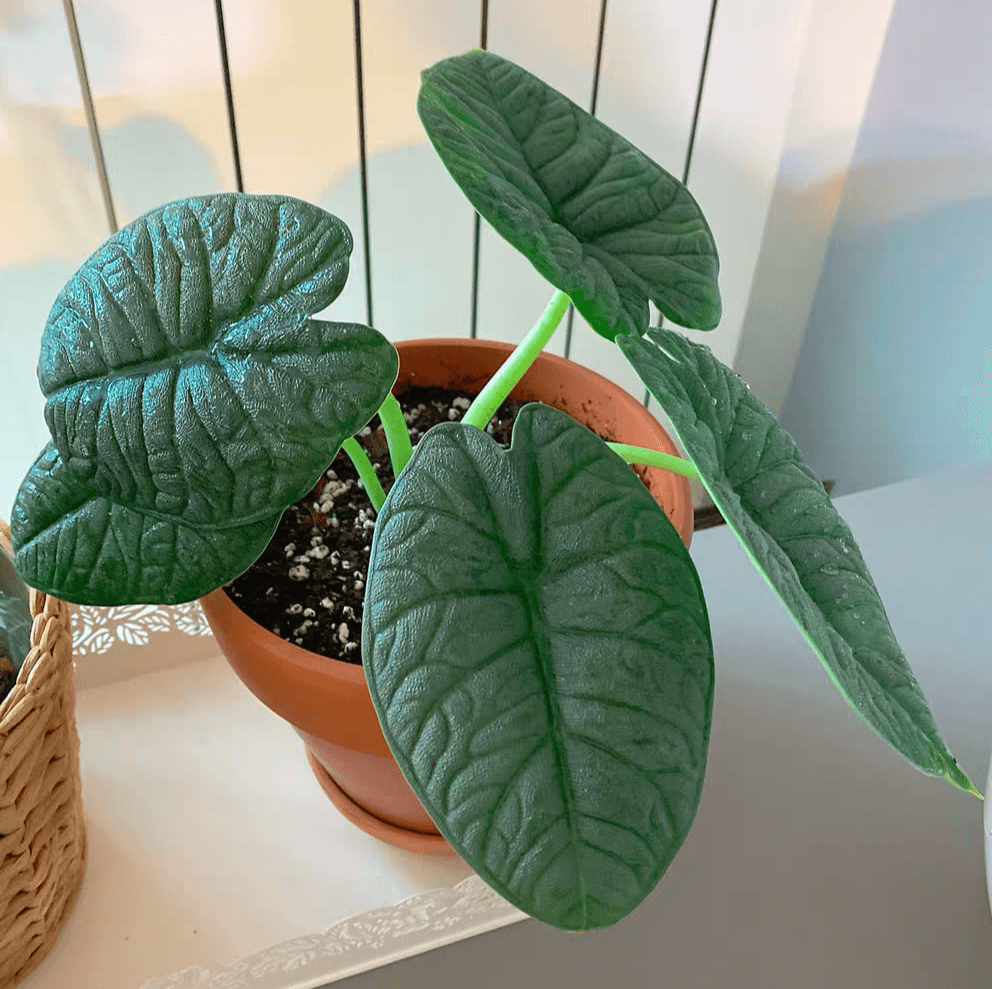
Also referred to as the Jewel Alocasia, the Alocasia Melo has an unusual oval shape with a tipped centre. They are appreciated as unique houseplants due to their thick and deeply textured leaves. This variety easily captivates onlookers with its attractive foliage markings.
Their dominant foliage colour is green. This variety can easily accentuate the outlook of your home so far they are placed in conspicuous locations and attractive containers. Asides from placing them in your living room or bedroom, you can enhance the beauty of your workstation or library by adding the Alocasia Melo as an option for interior decoration.
This variety can grow up to 2 ft. in height. For Alocasia Melo plants grown outdoors, ensure they receive regular bright sunlight to preserve and enhance their foliage appearance. Due to their thick texture, dust is likely to settle on the leaves toning down their attractiveness in the long run.
Misting helps prevent dust and dirt. This variety thrives when it is grown in warm temperatures. During extreme weather conditions, if grown in containers move them indoors. In addition, during winter, stay off fertilizing this plant. The appropriate time to fertilize the Alocasia Melo is during spring.
3. Alocasia Dragon scale
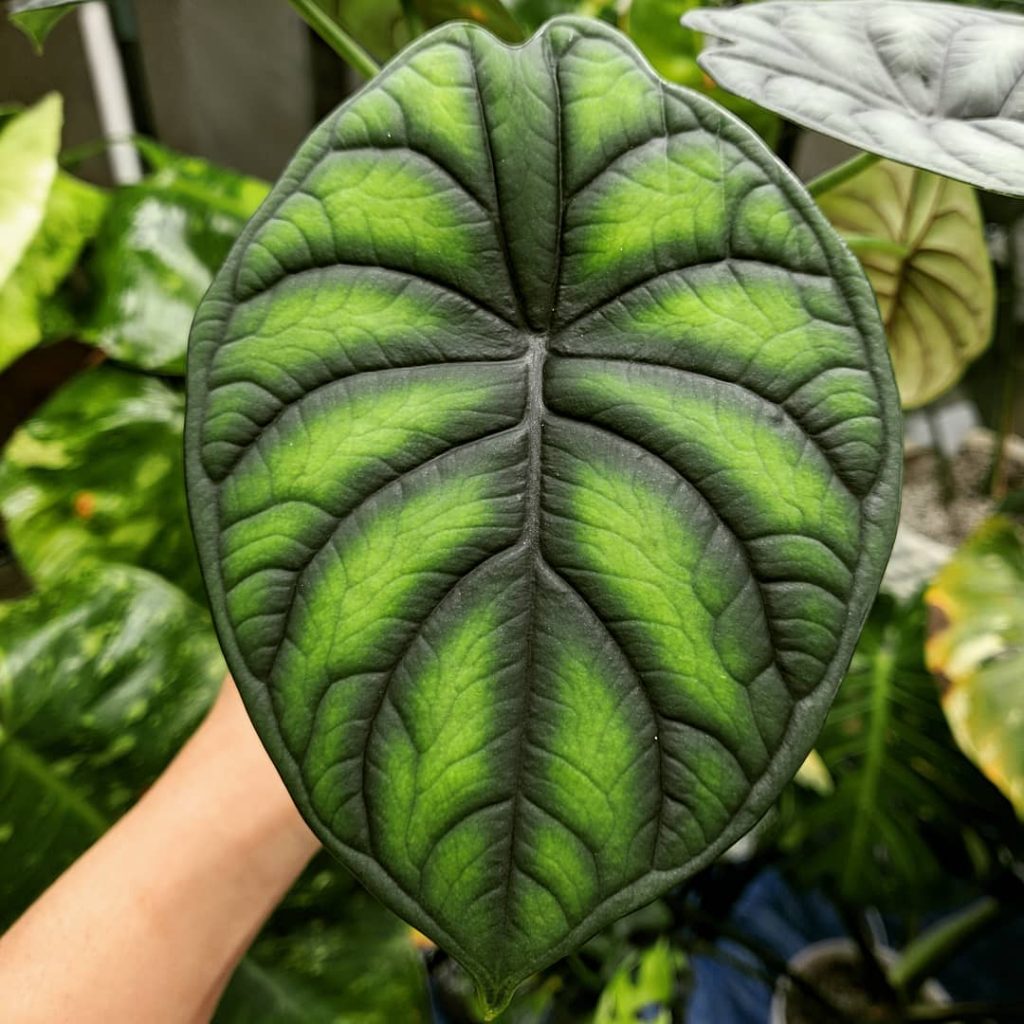
An unusual foliage name means the variety has a unique foliage design. The Alocasia Dragon scale variety has deeply marked and textured, gloss-like leaves. Their wide showy leaves easily blend into the interior design of any home. The dominant colour of the Alocasia Dragon Scale is green although in varied hues.
They are suitable for indoor and outdoor propagation but Dragon Scales grown outdoors are usually bigger when compared to their counterparts grown indoors. They can be placed on hanging shelves or dangle baskets depending on what suits your fancy or the model of your home.
Some growers get creative with their houseplants placements and end up constructing self-designed placement structures. Their basic growth needs are moderate watering, organic soil because it allows for good drainage and aeration, regular misting, appropriate temperature, and periodic fertilization.
The Alocasia Dragon scale should be grown in an area with temperatures between 60 °F-80 °F. Always look out for pests and watering levels as these are important factors that can hinder the growth of your plant.
4. Alocasia Black Velvet

The Alocasia Black Velvet is another stunning variety with a unique foliage design. They are commonly referred to as “Queen Alocasia”, and “Alocasia Velvet”. The Black velvet plant is heart-shaped with brightly coloured lines that spread across the foliage surface.
The Alocasia Black Velvet can be grown in nursery beds and containers. Also, they can be propagated as indoor and outdoor houseplants. This variety can grow up to 20 inches in height and about 18 inches in width. They thrive in temperatures between 60 °F-75 °F.
They thrive when exposed to adequate sunlight. Sufficient lighting would enhance the growth of the Black Velvet Plant.
The survival of this variety is hinged on adequate lighting; this is the reason growers are advised not to keep their Black velvet plants in poorly lit environments as their foliage appearance can get affected.
Their other growth needs are moderate watering, moist organic soil, proper temperature, and a warm temperature. Choose brightly coloured containers to pot them.
5. Alocasia Lauterbachiana
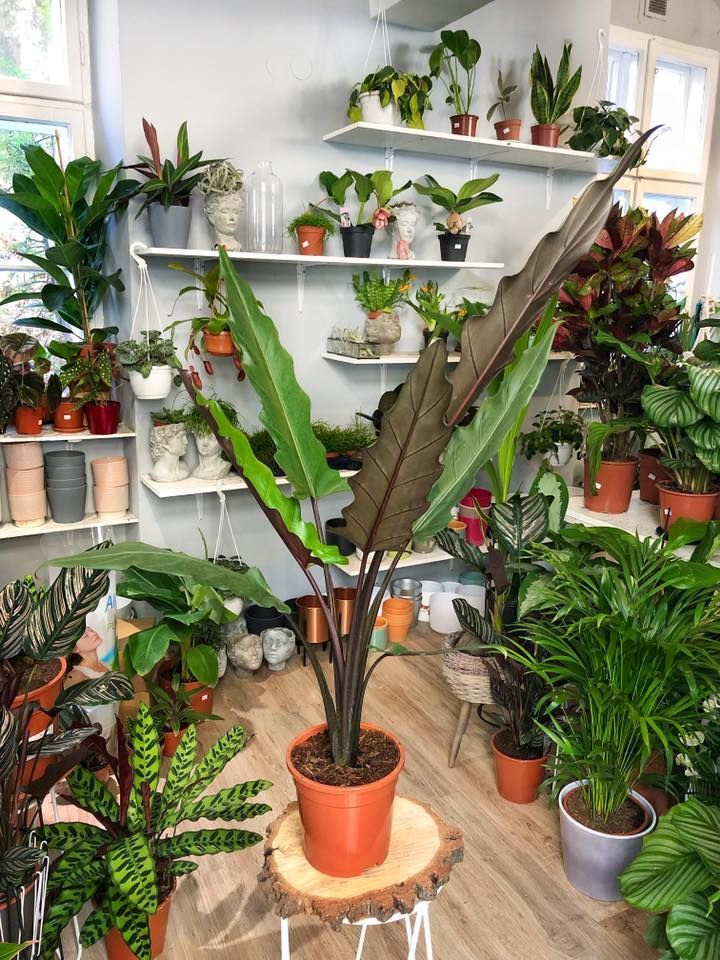
For foliage shape and design, the Alocasia Lauterbachiana has thick stalks with oval-shaped leaves; the leaves of the Alocasia Lauterbachiana have wavy edges. This is another popular variety that is common amongst Alocasia growers. Their prominent foliage colour is green, although they have a dark outer foliage colour.
They can be grown as both indoor and outdoor houseplants. They thrive in warm temperatures between 65 °F-75 °F. This variety should not be exposed to extreme weather conditions as this could lead to stunted growth.
They require moderate watering to survive. You must ensure their soil never completely dries out before watering them. In addition, the soil must never end up soggy after watering. Misting their leaves would improve their humidity level.
Regularly prune their leaves to remove unhealthy or dead parts to ensure speedy growth. Snipping off young leaves also boosts the growth rate of more leaves. If you desire a bushy mass, grow the Alocasia Lauterbachiana plant outdoors where it can receive maximum sunlight and an appropriate temperature.
6. Alocasia Frydek
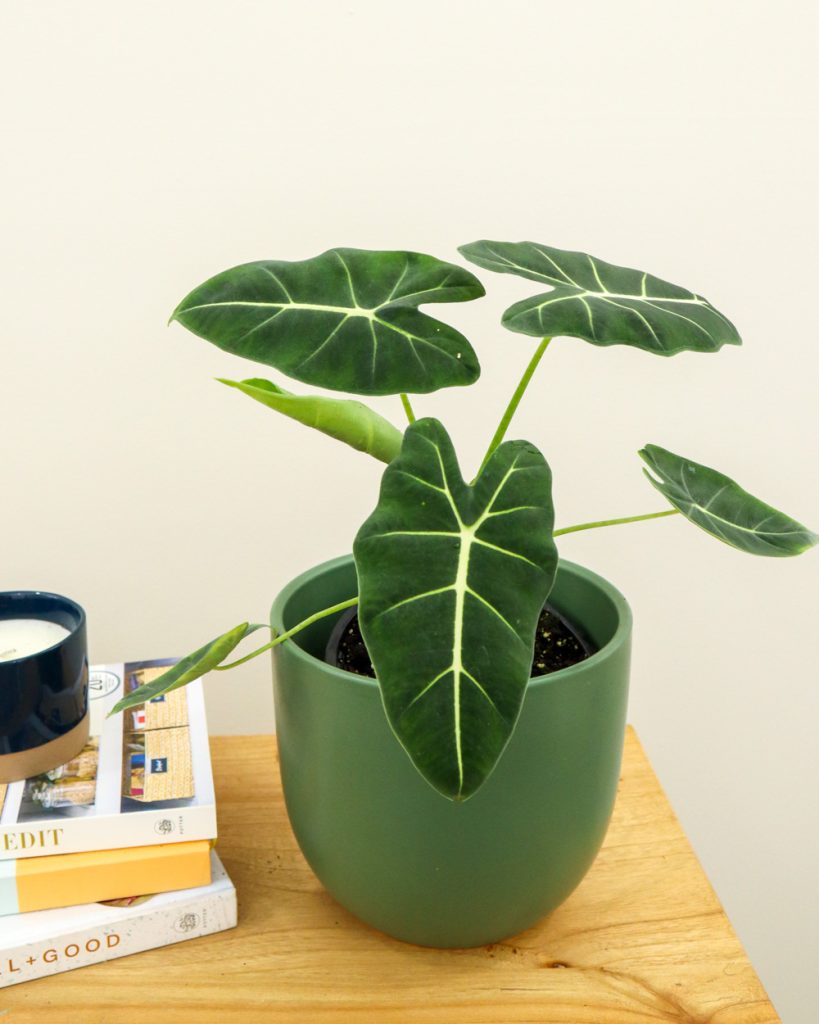
The Alocasia Frydek plant is a beautiful houseplant suitable for indoor and outdoor propagation. The Alocasia plant is heart-shaped with brightly coloured lines which span across the foliage surface. The prominent colours of this variety are green, and silver.
Alocasia Frydek plants grown outdoors tend to grow larger than those grown indoors. This variety can grow up to 3ft. In height and width. They thrive in areas they can receive bright indirect sunlight. For those grown indoors, they must be placed in locations they can receive sufficient lighting from the sun or artificial light.
Their placement should not deprive them of receiving proper lighting as this could affect their foliage colour and vigour. Your Alocasia Frydek can be taken outdoors to receive about 5 hours of sunlight before being taken indoors.
Ensure your Alocasia Frydek is displayed in an area where it can complement the interior design of your home. In addition, use colourful containers to pot them. The containers chosen must be well-drilled to allow proper drainage of water. This helps prevent waterlogged soil.
7. Alocasia Cuprea
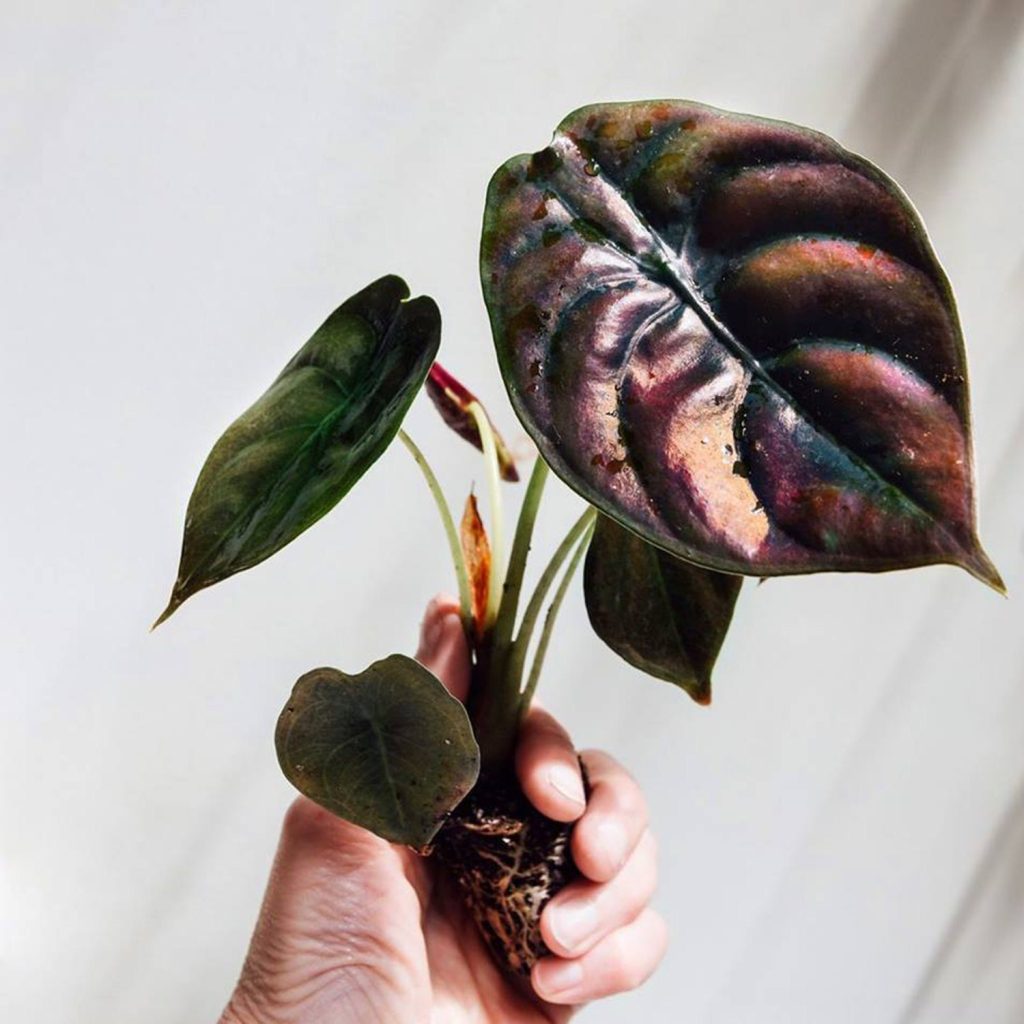
To some growers, the Alocasia Cuprea is the most attractive Alocasia variety. They are also referred to as Red Secret Alocasia. Their unique foliage colour and design make it a common option to propagate. For foliage colour, the Alocasia Cuprea has hues of green with a dark lining.
However, some varieties are pink and green. If you look closely at this variety, their foliage design has a semblance to a bug-like design. Their outer foliage colour is burgundy. This beginner-friendly variety can be propagated indoors and outdoors, although the growth rate would vary.
This variety should be considered if you want to decorate your home. Organic soil, regular and moderate watering, proper temperature and lighting, and appropriate fertilization is all your Alocasia Cuprea needs to survive.
Remember to dilute your fertilizer before application; this reduces its harsh effect on the plant. If grown indoors, ensure they receive about 5 hours of sunlight. You can move them outdoors to receive sufficient lighting daily before moving them indoors at a later time during the day.
8. Alocasia Calidora
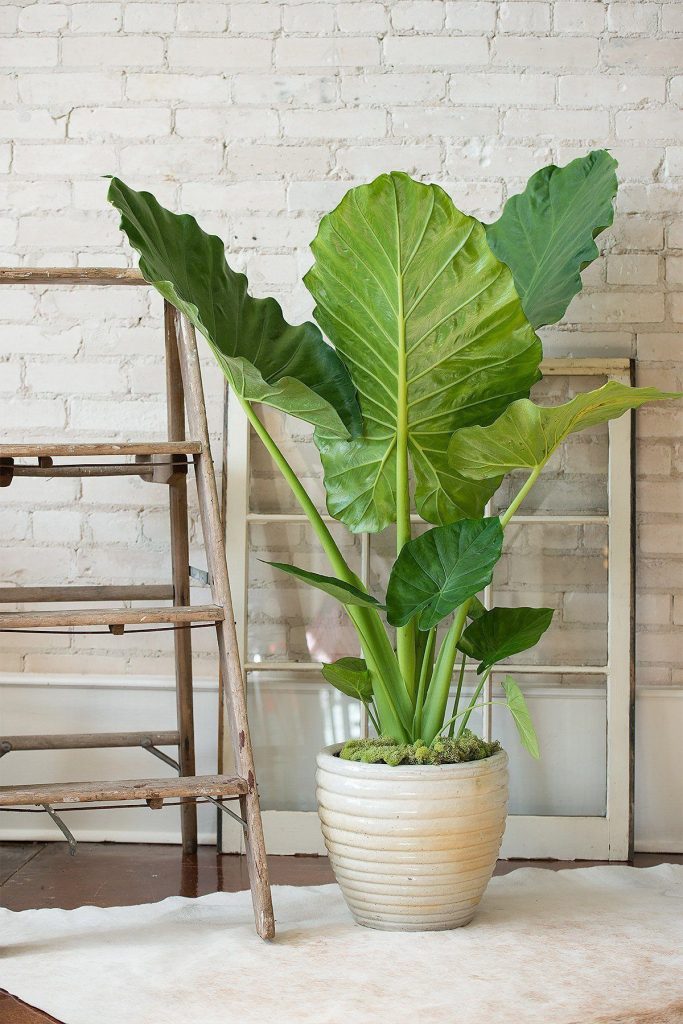
The Alocasia Calidora plant has a similar foliage appearance to the Alocasia Frydek. The major difference between these varieties is the Alocasia Frydek variety has white or silver markings on the foliage surface while the Alocasia Calidora variety is lined with wavy edges.
Their sturdy stalks make the plant appear appealing to onlookers. This variety can be grown indoors or outdoors depending on what you desire. For growers who want large sized Alocasia Calidora, they are advised to grow them outdoors where they can receive their growth requirements in a sufficient measure.
They are amongst the most popular Alocasia variety, so they are easy to purchase and are inexpensive. If you desire a compact-sized Calidora plant, grow them indoors. This variety does not grow into a bushy mass except when grown in nursery beds.
They thrive in temperatures between 60 °F-80 °F. They are commonly propagated because they are more drought tolerant than other varieties. This variety can grow up to 10 ft. in height and width.
9. Alocasia Stingray
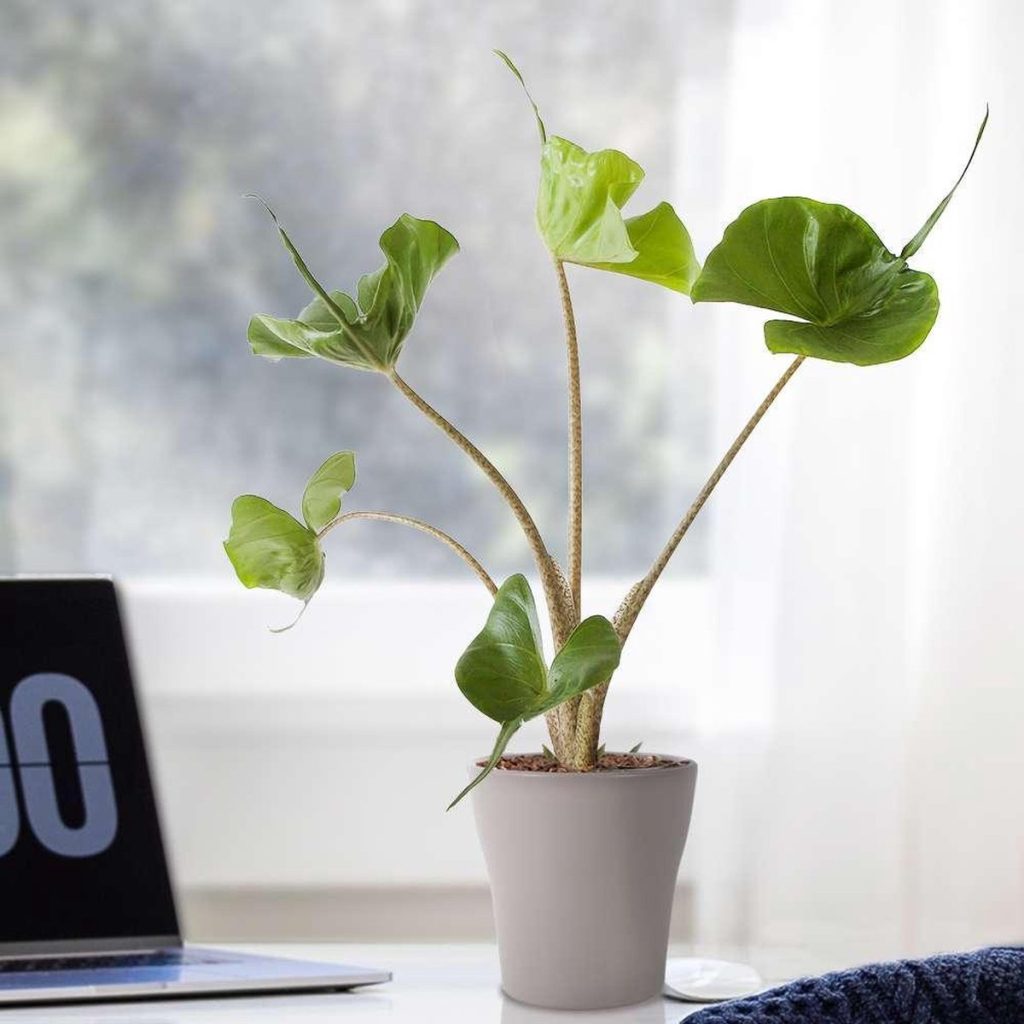
Unlike some varieties that are heart-shaped with their foliage markings, the Alocasia Stingray is not only heart-shaped but has a thin tail that extends at its bottom. This feature distinguishes them from other varieties. Their prominent foliage colour is Green.
Their glossy leaves make them attractive regardless of the location they are grown in. This variety should be grown in warm temperate conditions. They thrive when grown in moist organic soil and areas they can receive sufficient sunlight.
When grown outdoors, the Alocasia Stingray grows sturdy stalks that complement the vigour of the plant. Watering them regularly and moderately helps transport nutrients from the soil to the Alocasia Stingray.
Never allow your plant to dry out before watering them. In addition, be mindful when watering to avoid overwatering which could lead to soggy soil.
Regularly lookout for pest infestations and foliage appearance change especially for those grown outdoors. Ensure this plant is not positioned near radiators and air vents.
10. Alocasia Giant Taro
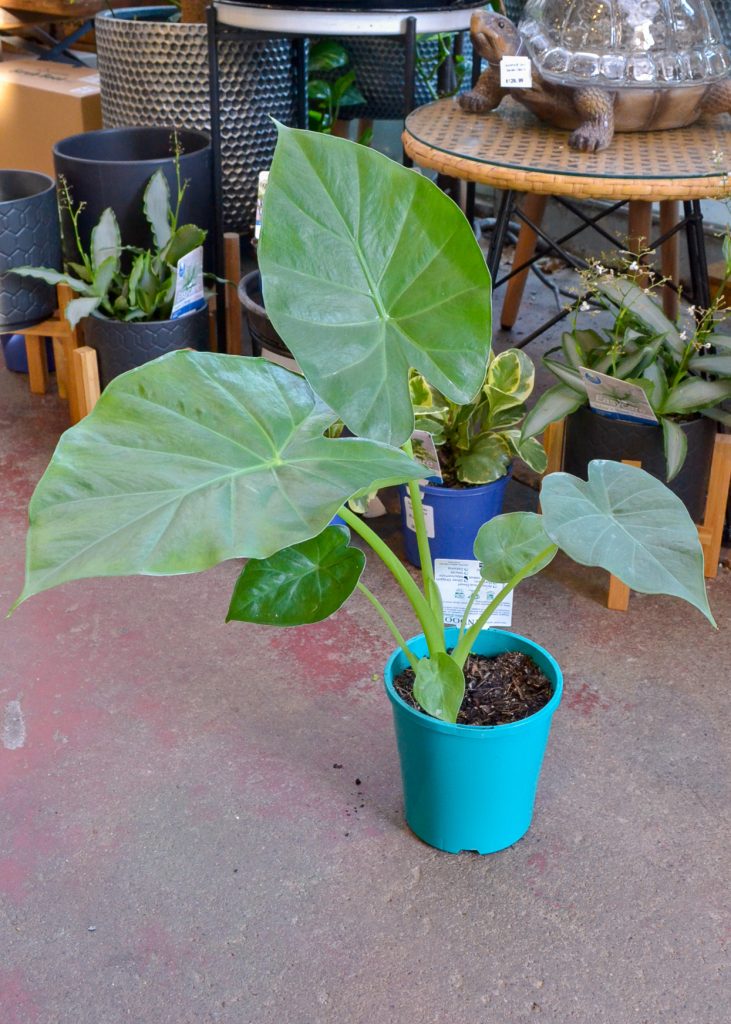
As the name implies, this variety is supersized and is mostly grown as an outdoor plant. They are heart-shaped with deep lines on the foliage surface. Properly tending to their growth needs ensures healthy growth of the Alocasia Giant Taro plant.
Ensure you shop from a reliable source if you would be ordering online. After receiving your order, properly care for this plant till there is noticeable growth. Some growers start the Giant Taro plant off as an outdoor propagation then once they have reached maturity, move them indoors.
Although this can be a good idea, growers should not move their Giant Taros indoors if their home is cramped. They require space to thrive, so they can receive sufficient light and water.
Once the plant outgrows their container, repot them and use a suitable container that can match their size. Since they are showy plants, they can be placed in any location within your home and office. Use a well-drilled attractive container to pot them.
Final Note
Which of these Alocasia varieties would you be adding to your houseplant collection? These varieties are low maintenance and require basic resources to survive.
We guarantee you a hitch-free propagation if you adopt the tips we provided for you. Kindly let us know the Alocasia variety you would be propagating soon.
More varieties of your favorite plants:
- Begonia Varieties: 10 Common & Rare Types Of Begonia
- Syngonium Varieties: 10 Common & Rare Types Of Syngonium
- Weigela Varieties: 10 Common & Rare Types Of Weigela
- Pothos Varieties: 10 Common, Rare Pothos Types For Your Home
- Spirea Varieties: 10 Common & Rare Types Of Spirea
- Heuchera Varieties: 10 Common And Rare Types Of Heuchera
- Peperomia Varieties: 12 Types Of Peperomia Plants
- Scindapsus Varieties: 6 Types Of Scindapsus Plants To Grow Today
- Pilea Varieties: 11 Types Of Pilea Plants To Grow Today

